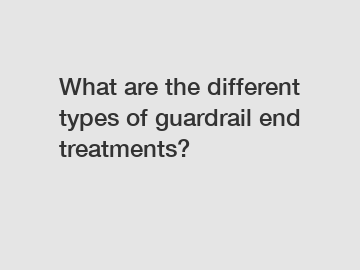What are the different types of guardrail end treatments?
What are the different types of guardrail end treatments? Guardrail end treatments refer to the various devices and designs used to provide improved safety and reduce the potential for injuries in case a vehicle collides with the end of a guardrail. There are several types of guardrail end treatments, including the flared end terminal (FET), the energy-absorbing (crash cushion) terminal, and the gating terminal.
The different types of guardrail end treatments have emerged as a result of extensive research, testing, and advancements in safety technology. The objective behind these treatments is to minimize the severity of an impact and redirect the errant vehicle away from the hazard.
The first type of guardrail end treatment is the flared end terminal (FET). This design features a flared shape at the end of the guardrail, allowing the vehicle to smoothly transition from the barrier to the roadway or into a soft-soil area. The flared end terminal reduces the likelihood of the guardrail penetrating the vehicle or causing potentially fatal injuries to the occupants. It also helps to absorb energy during impact.

The energy-absorbing or crash cushion terminal is another type of guardrail end treatment. It is designed to absorb and dissipate the kinetic energy of a colliding vehicle gradually. These terminals consist of different types of materials, such as water-filled barrels, sand-filled modules, or crushable foams. The energy-absorbing properties of these devices reduce the force experienced by the vehicle occupants, reducing the risk of severe injuries or fatalities.
Finally, the gating terminal is a type of guardrail end treatment that prevents errant vehicles from driving through the end of the guardrail. It consists of a series of gates that restrict the passage of vehicles while allowing them to be redirected safely. Gating terminals are particularly effective in preventing head-on collisions or vehicles being speared by the guardrail.
The implementation of these various guardrail end treatments has significantly improved road safety. They reduce the risk of vehicle intrusion, minimize the potential for injuries to occupants, and help prevent vehicles from overturning or being redirected into more hazardous areas. These advancements in guardrail end treatments have also influenced the development of safety standards and regulations, ensuring that the design and installation of guardrails meet specific criteria for effectiveness and performance.
In conclusion, the different types of guardrail end treatments, including the flared end terminal, energy-absorbing terminal, and gating terminal, have been developed to enhance safety and reduce the impact severity of vehicles colliding with guardrail ends. Through continuous research and advancements in technology, these treatments have immensely contributed to improving road safety by redirecting vehicles away from hazards, reducing the force experienced by occupants, and preventing vehicle intrusion.
For more How Far is the Spacing of Guardrail Posts, Dachu Traffic Facilities, Traffic Guardrails Manufacturerinformation, please contact us. We will provide professional answers.
55
0
0

Comments
All Comments (0)